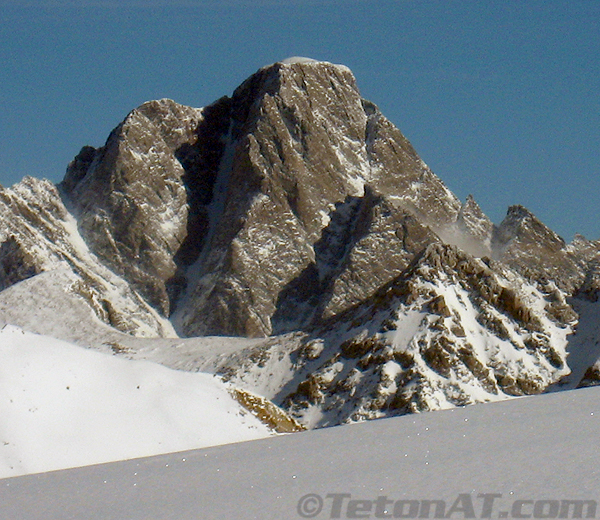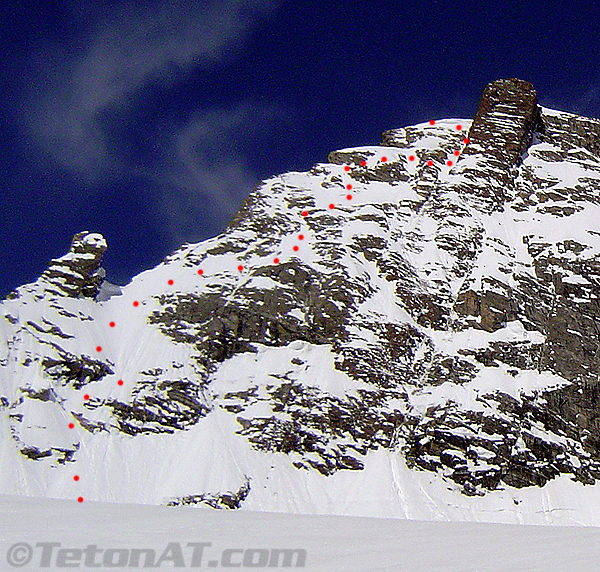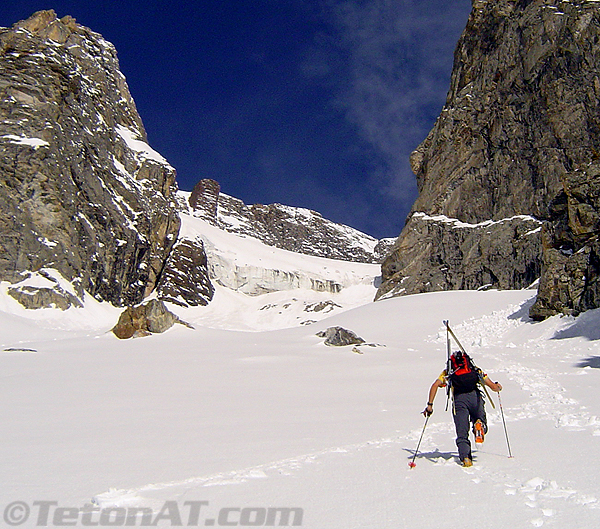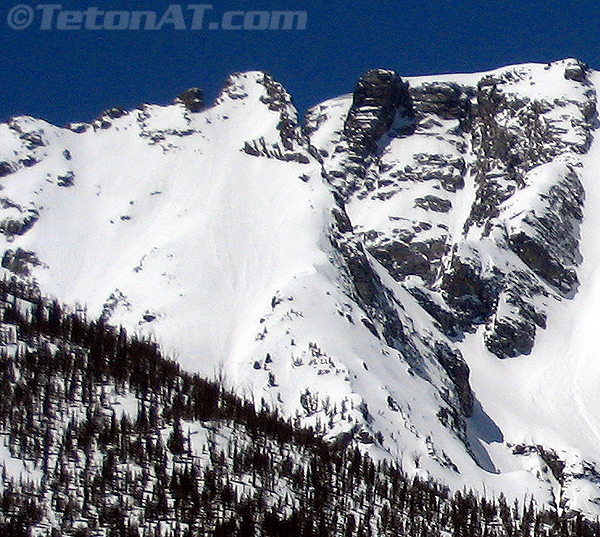Because of the immense overall size of Mount Moran there are many ski routes on the mountain, though only a couple come of summit without any sort of rappel. Most of the time, the broad, flat summit is stripped of snow by the wind, making a true summit descent challenging. Virtually every aspect of Moran has a ski route on it and today we will focus on the routes on the south side of the peak.

Southwest and Sandinista Couloirs of Mount Moran.
Southwest Couloir– This is a moderate angled couloir that offers close to 5000′ of skiing into Leigh Canyon. From the southwest, it stands out amongst a virtually continuous wall of rock on Mount Moran’s southern flanks. Though its upper couloir is protected from the sun by tall rock walls for the first half of the day, its lower slopes are due south facing, and often melt or get washed out by sloughs or avalanches from above. It also takes a good snowpack to fill in the lower cliff bands to allow for straight forward skiing. Though the lower cliff bands are not terribly technical to negotiate when free of snow, they may require a rope and it is best to ski this line when things are filled in. The biggest hazard of this line are sloughs/spindrift coming off the rock walls that rise above you, growing in size and/or triggering larger avalanches below. Best time of year to hit this line is late winter or early spring, after the park road is plowed and before the sun really heats things up.
Sandinista Couloir– Though the Sandinista Couloir has less overall vertical than the Southwest Couloir, it is much more challenging. Possibly due to its shorter length and extremeness, it has yet to have a known ski/snowboard descent. A heavy snow year is required to fill in the upper reaches of the line and make it go cleanly from the col at the top of the ridge. The couloir ends in a 200′ cliff at the bottom and since the top of the couloir sits well below the large southern side of the Fonda Ridge, attempts will probably come from below. It is similar to the Apocalypse couloir in that there is substantial objective hazard from sloughs from above, but the Sandinista takes it one step further due to the large cliff band at the bottom. Best time of year to hit this line is…?????.
Drizzlepus– Though starting well below the summit, the Drizzlepus is well worthy of a descent due to the aesthetic fin of snow that forms on its south side. Standing on top of the Drizzlepus offers incredible views of the CMC route, Black Dike, Falling Ice Glacier and East and West Horns. After connecting with the slopes below the Falling Ice Glacier, offers a direct fall line descent all the way to the shores of Leigh Lake. Best time of year to hit this line is late winter or early spring, after the park road is plowed and before the sun really heats things up.

CMC ski descent route on Mount Moran.
Note: This line is a best “guess-timate” and may not be exact.
CMC Route– Though I have thought this route has been “in shape” on multiple occasions since it’s first descent in 2002 by Hans Johnstone, Kent McBride, Bill Dyer and the late Doug Coombs, it has yet to be repeated. Requiring rappels, route finding, a keen eye for conditions and nerves of steel, the CMC Route is at the height of ski mountaineering in the Teton’s…if not the world. Connect with the Falling Ice Glacier or climb to the top of the Drizzlepus to reach the Leigh Lake. Best time of year to hit this line is in the spring after a big storm has had a chance to fill in and link the patches of snow on the face.

Hiking up the Falling Ice Glacier.
Falling Ice Glacier– A moderate run between the East and West Horns on one of the three glaciers that call Mount Moran home. The upper sections of the glacier are low angle, but the slope soon rolls over and open crevasses are past on the skiers left. Although the lower sections often melt out early due to its southern exposure, it makes a great spring corn run in a phenomenal setting. Best time of year to hit this line is late winter or early spring, after the park road is plowed and before the sun really heats things up.

East Horn and Upper CMC Route.
East Horn– Toping out at nearly 11,500′, the East Horn is a worthy objective for any ski mountaineer looking to hit aesthetic lines. Its steep East Face draws the eye of skiers and would be a great consolation prize combined with a camping trip to ski the Skillet or any other descents nearby. A deep snowpack will make the descent more enjoyable, covering cliff bands and making them skiable rather than having to be avoided. Best time to ski this line is anytime you can get there when the snow conditions are good and avalanche danger is low.
(ref: Teton Skiing: A History and Guide to the Teton Range,
Select Peaks of Greater Yellowstone)


Steve, guidebook series = Awesome! Thanks!
thanks dude!